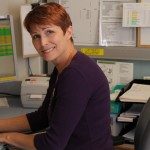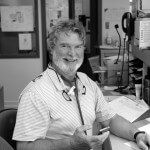Lady Minto Hospital’s Emergency Room—The Jewel In The Crown

If you ask any one of the island realtors what the most important requirement is for clients considering a move to Salt Spring Island, they will say without hesitation, “There must be a hospital with an Emergency Room.”Many islanders have based their final decision to move here on that fact. The Lady Minto ER is without a doubt the hospital’s jewel. Where else would you receive hot blankets, hot tea and hot muffins baked in-house? …and where else would you encounter such an amazing team of doctors, nurses and other health professionals ready to handle anything that comes through the doors? You might even be seen within 20 minutes, which is unheard of in the big city.
The hospital has 12 doctors that rotate through 12 or 24-hour shifts in the Emergency Department. It is a requirement for getting medical staff privileges at the hospital. This means having all of the necessary certifications and training to handle anything that presents in Emergency and keeping up to date with training and technology through ongoing education.
I spoke with a few members of our team and got a better sense of the challenges and rewards of rural medical practice and what is entailed in providing Emergency Room coverage.

Dr. Holly Slakov gave up her full time medical practice in 2003 to free up some time for her growing family. By then she had three young children. “I had to give up something,”she said, “so I decided to focus my medical career on emergency medicine.”In her role at Lady Minto’s ER, she is able to control which shifts she covers and streamline her work schedule. She now provides regular coverage for 12 hour shifts, often on week-ends, which helps to free up time for the other G.P.s. In order to prepare for this role, she worked shifts at the Royal Columbian Hospital in New Westminster to expand her ER experience. “At a big city hospital, you have lots of back-up. Here, at Lady Minto, you don’t see the same volume of cases but you must be ready for anything that comes through the door.”Practicing in a rural facility provides a huge range of possibilities. “People think ER work is so difficult,”she says, “but I think that what family physicians do in their clinics everyday is what is difficult and this is not recognized. The health care system is a team and no one part or individual can function alone. We are lucky on SSI to have a team.”
I spoke with Dr. Shane Barclay about the Emergency Room and he was excited to report that he has been able to organize an intensive course on the F.A.S.T. Ultrasound (a portable ultrasound machine purchased by the Foundation for use in the ER) this fall. There are 30 conditions that can be identified using this equipment. The course will focus on the top 4: fluid around the heart, aortic aneurism, abdominal bleeding due to trauma, and ectopic pregnancy.

The course is put on by the founders of EDE (Emergency Department Echo) and affiliated with the Canadian Emergency Ultrasound Society (CEUS). Dr Ray Wiss, an ER doc from Ontario, founded the EDE course some 15 yrs ago. Dr. Barclay is hosting the course and will be one of the instructors but other instructors will come from elsewhere, mainly western Canada. There are usually 5 instructors and 8 ‘students’per course day.
“We have a great, dedicated nursing staff who are eager to learn,”says Dr. Barclay. “They participate in monthly ‘Megacode’rounds which are now being attended by the doctors as well. There was a recent joint (RN and MD) trauma/ER simulation day in Nanaimo which had a full simulation emergency room for teaching.”Dr. Barclay acknowledges the Foundation’s fundraising and community support which in turn allows the staff to have the most up-to-date equipment available. Visiting doctors have often commented on how well our ER is equipped.
I asked several of the doctors, including Dr. Barclay and Dr. MacPhail, what is on their wish list for our ER, and what are the challenges they currently face.
“We have very little room to put new ER equipment!”Dr. Barclay states. “Space is the biggest issue in working in our ER from a patient safety/infection control perspective, as well as privacy. It is taxing enough just having space to do suturing or cast application, but for cardiac arrests and trauma it becomes almost overwhelming trying to work in the restricted space.”Dr. MacPhail agrees that space is a major issue. The Foundation is aware through the facility’s site manager, Bill Relph, that expansion of the Lady Minto ER is definitely on VIHA’s major capital project list. A date has not been set but we are poised and ready to fundraise for this most important project.
Another subject raised by most of the ER doctors was the issues around patient transfers to higher levels of care. “Transfers sometimes pose a challenge,”Dr. Slakov says. “There are two systems to deal with: VIHA’s higher level of care and the B.C. Ambulance Service. Both need to be coordinated by our ER team. Often it comes down to ‘bed control’, a VIHA system where the availability of beds is monitored and tightly controlled. They have a ‘no refusal’policy, but sometimes the system is cumbersome.”
Our Laboratory and Radiology staff are key team players and carry out diagnostic testings on a 24/7 basis. Dr. Morse, our General Internist, is also available to see emergency room patients and provides urgent diagnostic endoscopy procedures (as well as booked procedures) when required.
I spoke with Jo Twaites, Clinical Coordinator, about the special training and requirements for rural nursing and the vast diversity of experience needed to work a shift at Lady Minto. She explained that newly hired nurses have a program of education and experience before they are given ER shifts. There is an extensive checklist of courses that they must take either as a one-time course, or annual re-certification. The list is extensive (Cardiac Rhythm Interpretation, The Canadian Triage Assessment Course, Advanced Cardiac Life Support, Trauma Nursing Core Course, Neonatal Resuscitation, Emergency Nursing Pediatric Course, Hazardous Material Decontamination, Suicide Screening, Delirium Education) but I was unfamiliar with a specialised course called Strangers in Crisis: a course on helping patients and families cope with the stresses of emergency visits. This would provide invaluable tools for staff working here.


This year, Jo identified the need for better unit clerk coverage and created two permanent positions for Nursing Unit Assistants on Acute Care. These specialized assistants provide 7 days/week coverage, from 0745 am to 7 pm. They are really the first stop for patients presenting at emergency. They take care of all of the paperwork, organize tests when ordered and transcribe doctors’orders onto the medical chart. Lori Teather and Susanne Dollheiser were hired into the positions this spring. “You have to be very well organized and able to keep track of a great number of details throughout the day,”explains Lori. “It is also essential to remain calm. This is certainly a major requirement of the job.”Some of the challenges include deciphering doctors’handwriting, being familiar with hundreds of medication names, and staying well organized in a small space. “You are always multi-tasking in this job. You must be an organized and analytical thinker.”

Anastasia Williams, Mental Health & Addictions Nurse, is another specialized team member who provides emergency care. Along with the emergency mental health workers, who are trained counsellors and work from 4 pm to midnight 7 days a week, she is ready and available to provide assistance with mental health emergencies. Cases include a wide range of mental health illnesses such as severe depression, anxiety, difficulty coping with stressors and suicide attempts. Patients with substance abuse problems are also seen in emergency. Anastasia works with the hospital psychiatrist, Dr. Montalbetti, and also provides follow up care for mental health out-patients. Recently, Anastasia taught a course on Violence Prevention in the Workplace, a required course throughout VIHA and available to all staff.
I spoke to Dr. White about the transition from big city medical practice to Salt Spring Island. He confesses he is the oldest G.P. on the team and has a “love/hate”relationship with emergency work. “Much like when I was young and covering obstetrics, things can go wrong for reasons beyond the scope of medicine. As a doctor, this can be really tough.”

Dr. White acknowledges that here at Lady Minto, it is all about team work. “We have some great nurses working in the ER. Another thing that makes the department function well is the B.C. Air Ambulance service. The paramedics are exceptional –top of their game. They now have an ‘auto-launch’protocol which means that the paramedics can decide to airlift a patient directly from the scene of an accident.”
After a long and difficult 12 hour shift, I asked Dr. Slakov how she “shakes off”the effects of the day. “A hot bath!”she says. “Or a long run. Something physical to de-stress really helps. A few of us meet regularly to debrief and review cases and provide support for one another. Confidentiality is paramount so we can’t talk to friends or family. It really helps to be able to share among peers and team members.”

Leave a Reply
Want to join the discussion?Feel free to contribute!